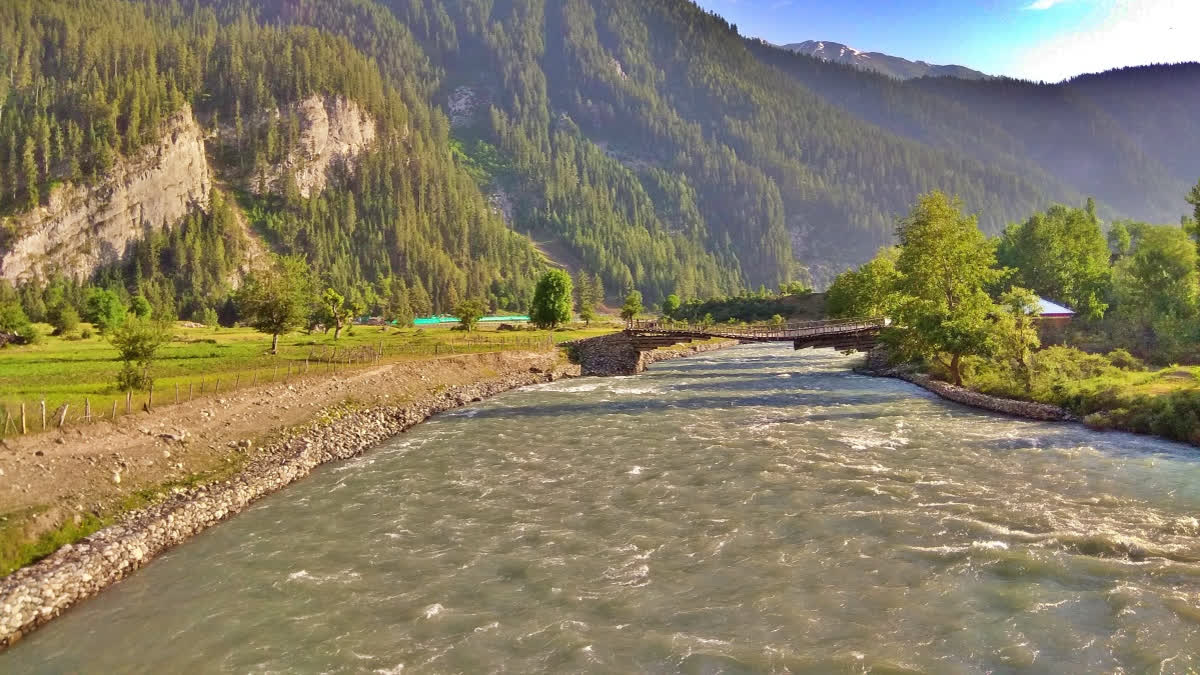New Delhi: The visit by a three-member delegation from Pakistan to inspect hydroelectric projects in Jammu and Kashmir falling under the Indus Waters Treaty (IWT) should not be seen as something unusual.
Though some media reports are highlighting that the visit comes five years after the revocation of special status to Jammu and Kashmir by New Delhi, one should see it from the perspective of the IWT that has withstood the test of time over seven decades despite the tumultuous relationship between India and Pakistan.
“The visit is a normal exchange,” Uttam Kumar Sinha, Senior Fellow at the Manohar Parrikar Institute of Defence Studies and Analyses and a leading commentator on trans-boundary water issues, told ETV Bharat. “The Permanent Indus Commission (PIC) meets once every year. India has been very transparent on the IWT.”
Describing the IWT as a “remarkable treaty”, Sinha said: “That the Treaty has lived is because India respects being its signatory and values trans-boundary rivers as an important connector in the region both in terms of diplomacy and economic prosperity. There have been several occasions – the three wars, the Indian Parliament attack in 2001, the Mumbai terror attack in 2008, the terrorist attacks in Uri in 2016 and the 2019 Pulwama attack - which could have prompted India, within certain conditions, to contemplate withdrawing from the IWT. However, on each occasion, based on its cost-benefit assessments, India chose not to.”
During its current visit, the Pakistani delegation will inspect the Kishenganga and the Ralte hydroelectric projects in the Chenab valley. In January 2019, a Pakistani delegation had inspected the Pakal Dul and Lower Kalnai hydroelectric projects.
So, what are the IWT and the PIC under it?
The IWT is a water distribution treaty between India and Pakistan, arranged and negotiated by the World Bank, to use the water available in the Indus River and its tributaries. It was signed in Karachi in September 1960 by then Indian Prime Minister Jawaharlal Nehru and then Pakistani President Ayub Khan.
The Treaty gives control over the waters of the three “eastern rivers” – the Beas, Ravi and Sutlej – to India, while control over the waters of the three “western rivers” – the Indus, Chenab and Jhelum – is with Pakistan. The treaty establishes a cooperative mechanism for exchanging information between the two countries regarding the use of the western rivers allocated to Pakistan and the eastern rivers allocated to India.
The preamble of the treaty recognises the rights and obligations of each country in the optimum use of water from the Indus system in a spirit of goodwill, friendship and cooperation. The treaty allows India to use the western river waters for limited irrigation use and unlimited non-consumptive use such as power generation, navigation, floating of property, and fish culture.
Under the Treaty, a Permanent Indus Commission (PIC) was established. The Commission has a commissioner from each country to oversee the cooperative mechanism.
The Commission is required to meet at least once a year to discuss the implementation of the treaty and address any issues that arise. The PIC conducts regular inspections and tours of the rivers and works to monitor compliance and resolve minor issues on the spot. It oversees the exchange of river flow and hydrological data between the two countries, ensuring transparency and adherence to treaty provisions. The Commission serves as the first line of dispute resolution, aiming to settle differences through direct dialogue. If issues cannot be resolved, they may be referred to a neutral expert or a court of arbitration.
So, why are the Kishenganga and Ratle hydroelectric projects the focus this time?
The Kishenganga hydroelectric project is situated on the Kishenganga River (called Neelum in Pakistan), a tributary of the Jhelum river in Bandipora district of Jammu and Kashmir. It is designed to generate 330 MW of hydroelectric power. It’s a run-of-the-river scheme with diversion of water from a reservoir through a 23.25-km-long headrace tunnel to an underground power house. The project features a 37-metre high concrete-faced rockfill dam. It houses three units of 110 MW each and is expected to produce about 1,713 million units of electricity annually.
The Ratle hydrolectirc project is being constructed on the Chenab River in Kishtwar district of Jammu and Kashmir. It is designed to generate 850 MW of hydroelectric power. It is a run-of-the-river scheme with a concrete gravity dam. The project will have a 133-meter high dam. It will house five units - four of 205 MW each and one of 30 MW – and is expected to produce about 3,136 million units of electricity annually.
Both India and Pakistan held different positions when Islamabad raised objections regarding the technical design features of the Kishanganga Ratle (850 MW) hydroelectric power plants located on the tributaries of the Jhelum and the Chenab, respectively, designated as “Western Rivers”.
However, under certain articles of the IWT, India is permitted to construct hydroelectric power facilities on these rivers. Pakistan then approached the World Bank to facilitate the setting up of a court of arbitration to address the concerns related to these two projects. India requested the appointment of a neutral expert, referent to Clause 2.1 of Article IX of the IWT on the settlement of differences and dispute of the treaty.
In October 2022, the World Bank appointed Michel Lino as the Neutral Expert and Sean Murphy as the Chairman of the International Court of Arbitration (ICA), acceding to both the South Asian neighbours’ requests.
However, last year, India said that the neutral expert is already seized of the differences pertaining to the Kishenganga and Ratle projects. New Delhi asserted that the neutral expert proceedings are the only Treaty-consistent proceedings at this juncture, and the Treaty does not provide for parallel proceedings on the same set of issues.
“India has been participating in the Treaty-consistent neutral expert proceedings,” the External Affairs Ministry had said following the ICA ruling. “India cannot be compelled to recognise or participate in illegal and parallel proceedings not envisaged by the Treaty.”
“Pakistan does not want Kashmir to benefit from the use of the waters of these two rivers,” Sinha, author of the book Indus Basin Uninterrupted: A History of Territory and Politics from Alexander to Nehru, said. “It is a political issue for Pakistan. Water is just a disguise. The larger political issue is Kashmir.”
Explaining that water issues are always emotional, he said: “Pakistan always wants to rake up these issues in international forums like the ICA and the UN. The IWT is a matter of interpretation. India wants a bilateral solution under the PIC.”
Read More



